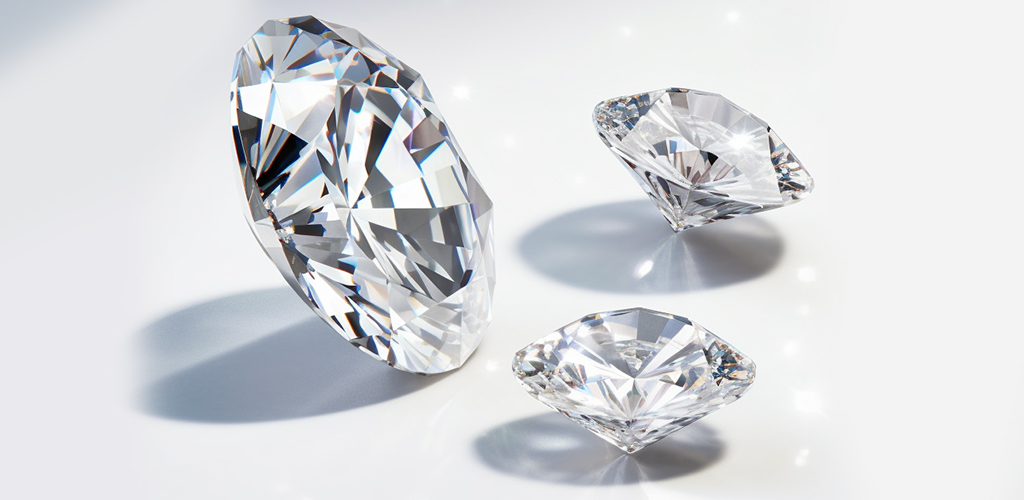The 4Cs Explained
Cut
Lab-Grown Diamonds: The cut of a diamond significantly impacts its brilliance and sparkle. Lab-grown diamonds can be sliced to any shape and style, from round brilliant to emerald or cushion cuts. The quality of the cut determines how well the diamond mirrors light. Lab-grown diamonds are in many cases sliced to the same high standards as natural lab diamonds 4Cs, ensuring that they exhibit optimal brilliance and fire.
Moissanite: Moissanite also benefits from precise cutting techniques. Because of its higher refractive index compared to diamonds, moissanite frequently appears significantly more sparkling. Moissanite can be cut into various shapes, and its exceptional fire can bring about a rainbow-like impact that is sometimes more intense than that of diamonds. While the cut quality of moissanite is crucial for its appearance, it doesn’t always adhere to the same cutting standards as lab-grown diamonds.
Color
Lab-Grown Diamonds: Lab-grown diamonds arrive in a range of colors, very much like natural diamonds. They are graded on a scale from D (colorless) to Z (light yellow). Most lab-grown diamonds are created to be near-colorless, falling among D and G on the color scale. They can exhibit similar color ranges to natural diamonds, offering options for various inclinations and budgets.
Moissanite: Moissanite generally exhibits a slight color, frequently with a faint yellow or greenish shade, although high-quality moissanite is designed to be near-colorless. While moissanite’s color is less noticeable to the naked eye, it doesn’t match the colorlessness of top-grade lab-grown diamonds. For those seeking a totally colorless appearance, lab-grown diamonds may be a better choice.
Clarity
Lab-Grown Diamonds: Clarity alludes to the presence of internal or external imperfections, known as inclusions and blemishes. Lab-grown diamonds can be created to high clarity standards, frequently surpassing many natural diamonds with regards to purity. They are graded from Flawless (no inclusions visible under 10x magnification) to Included (inclusions visible to the naked eye). The clarity of lab-grown diamonds can be comparable to or far superior to natural diamonds.
Moissanite: Moissanite typically has less inclusions and can be manufactured to exceptionally high clarity standards. Because of its lab-created nature, moissanite can appear cleaner than many diamonds. However, since moissanite is not graded on the same scale as diamonds, the clarity of moissanite may not always be directly comparable. It is generally considered to be of high clarity, making it an attractive option for those seeking a clear, sparkling gemstone.
Carat Weight
Lab-Grown Diamonds: Carat weight measures the size of the diamond. Lab-grown diamonds are available in various carat sizes, very much like natural diamonds. The carat weight can affect the price significantly, with larger diamonds being more expensive. Lab-grown diamonds provide a more affordable option for larger carat weights, allowing purchasers to get more for their money.
Moissanite: Moissanite is available in a wide range of carat sizes. Because moissanite is generally more affordable than diamonds, you can frequently afford a larger stone at a lower cost. Moissanite’s greater brilliance can make it appear larger and more impactful than a diamond of the same carat weight. This can be an attractive feature for those looking for a sizable and dazzling gemstone without the high price tag.
Comparing Lab-Grown Diamonds and Moissanite
Value and Pricing
Lab-grown diamonds are typically more affordable than natural diamonds however are priced higher than moissanite. Moissanite is a financially savvy alternative to both natural and lab grown diamonds, providing phenomenal value for those on a budget. Its cheaper makes it an appealing option for larger stones or more intricate settings.
Ethical Considerations
Both lab-grown diamonds and moissanite are considered ethical choices compared to mined diamonds. Lab-grown diamonds are created in controlled environments, reducing the environmental impact and ethical issues associated with traditional diamond mining. Moissanite, being entirely lab-created, avoids these concerns entirely and is a responsible choice for environmentally conscious consumers.
Appearance and Personal Inclination
The choice between lab-grown diamonds and moissanite frequently boils down to personal inclination. Lab-grown diamonds offer the traditional look and feel of natural diamonds with the added benefit of being more affordable and ethically obtained. Moissanite, with its higher brilliance and cost-effectiveness, provides a striking alternative that appeals to many purchasers.
Conclusion
Understanding the 4Cs — Cut, Color, Clarity, and Carat weight — is crucial while choosing between lab-grown diamonds and moissanite. The two options offer distinct advantages, with lab-grown diamonds providing a traditional diamond experience and moissanite offering exceptional brilliance and affordability. By considering your inclinations, budget, and values, you can make an informed decision that aligns with your requirements and style.

 Why Civil Construction Companies Are the Best Choice for Developing School Facilities
Why Civil Construction Companies Are the Best Choice for Developing School Facilities  Immigration Lawyer in San Antonio: Expert Legal Assistance for Your Immigration Needs
Immigration Lawyer in San Antonio: Expert Legal Assistance for Your Immigration Needs  Diamond Initials: A Personal Touch to Luxury with Lab Created Diamonds
Diamond Initials: A Personal Touch to Luxury with Lab Created Diamonds  The Timeless Elegance of the Oval Diamond Ring with Man Made Diamonds
The Timeless Elegance of the Oval Diamond Ring with Man Made Diamonds  The Timeless Allure of Pear Diamond Engagement Rings
The Timeless Allure of Pear Diamond Engagement Rings  Sparkle with Purpose: The Beauty and Value of Lab Grown Diamond Earrings
Sparkle with Purpose: The Beauty and Value of Lab Grown Diamond Earrings  The Importance of Sod Installation and Choosing the Right Soil for Your Landscape
The Importance of Sod Installation and Choosing the Right Soil for Your Landscape  Diamond Cuts: A Guide to Choosing the Perfect Cut for Your Jewelry
Diamond Cuts: A Guide to Choosing the Perfect Cut for Your Jewelry 




